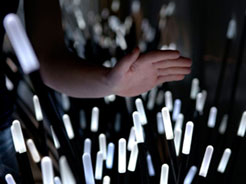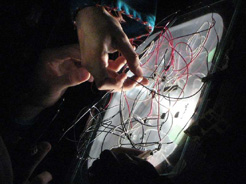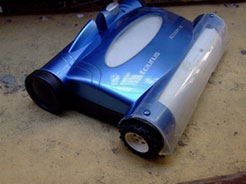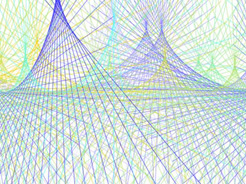22th to 27th sept 09 | Español

![]()
About us | Symposium FUTURE NOW | Digital Image | Stage | Art - Science - Innovation | Prize | Workshop | Open Tech | contact & staff |
![]()

![]()
photos | place | program | madeinCanarias | sponsors | e-digital data | travel | press | newsletter | e-news | multimedia | agenda |
![]()

ALEXIS Rodolphe y Yoko / FUKUSHIMA
France / Japan
www.citysonics.be/main.php?elem=event&id=285〈=en&op=08
Project: Growth’s growl (Creation)
A Japanese French duo offers a healthy life installation, an allegory through the animal kingdom of the problems of managing sustainable development and resources. Through one hermetically sealed case, we can monitor the growth in a community of flies and worms, a community that expands within a closed environment, with one significant though more primitive resource, one that is not renewable: 300 grammes of cheese. It is a process that evolves, forcing a fauna to adopt an attitude of ultimate survival. Beyond the visual aspect, these microcosms exist through the sounds they emit: sensors and microphones capture the buzzing of growth. The volume increases when the sample is closer. The force draws the viewer/observer/audience towards it in a sensation of immersion and oppression. An animal metaphor that reflects our own behaviour and makes us aware of the environment and its future. This project is also a homage to Richard Fleischer's 1973 film Solvent Green.

Christian Lohre
Germany
www.myspace.com/delaytv
Project: Friendlyfire
El comportamiento de jugadores on-line, más específicamente en los juegos de acción bélica (egoshooter games), conectados a través de internet por todo el mundo, es recodificado en tiempo real en una imagen física de sus acciones virtuales: se genera un paisaje tridimensional en constante movimiento que representa de una forma totalmente diferente y en otro lenguaje al inicial, la evolución del juego. Por medio de un interface se convierten las señales de sonido en coordenadas en el plano espacio-tiempo: El flujo de sonidos proveniente del juego (audiostream) es previamente multiplicado, filtrado, ordenado y direccionado hacia una matriz de altavoces que conforman la base de la escultura, asignando a cada sonido un altavoz determinado, de tal forma que la actividad sonora se reparte de forma hetereogénea por toda la matriz. Encima de esta matriz de altavoces se extiende una membrana que recoge las ondas de sonido provenientes de los altavoces y las traduce en vibraciones. Sobre esta membrana se encuentra una capa compuesta por cientos de bolitas de corcho blanco de embalaje. Éstas, al vibrar la membrana, saltan hasta una altura determinada por la intensidad del sonido generado por el altavoz que se encuentra debajo. Así se forma una topología, un paisaje generado por esas bolitas, en constante movimiento y transformación. Adicionalmente, se proyectan sobre esta topología metamórfica estructuras audioreactivas generadas aleatoriamente a partir del mismo streaming de audio.

Daan Roosegaarde
Netherland
www.studioroosegaarde.net
Project: Interactive landscape \'Dune\'
In a time which shifts from analogue to digital artist Daan Roosegaarde creates interactive artworks which explore the dynamic relation between architecture, people and e-culture. In this interaction his sculptures create a situation of \'tactile high-tec\' where visitor and (public) space become one. Our most recent version of \'Dune\' is an interactive landscape which reacts on the behavior of people. This hybrid of nature and technology exists out of large amounts of fibers which are brightened according to the sounds and motion of passing visitors. Inspired by the novels of J.G. Ballard, ‘Dune’ looks to the future as an opportunity to expand the human body limits to the digital surroundings. ‘Dune’ will function as a mediator which will bring architecture closer with its visitors, in a space composed by a physical and digital reality; a new reality of the supernatural. Recent artworks of Daan Roosegaarde have been internationally exhibited at Rotterdam City of Architecture, Netherlands Media Art Institute, V2_, Tate Modern London, \'Microwave\' Hong Kong, YCAM Japan and National Art Center Tokyo. More images, movies and articles at www.studioroosegaarde.net

Schmuch Jeldrik
Austria
www.jeldrik.com
Project: Let\'s talk about art
Let us talk about art is a critical on screen artwork that deals with the psychological aspects of modern abstract art works and the relation of form and alignment and their effect on the spectator. Whole books and articles could be found dealing with just one single art piece to tell us how to interpret them and what to see in them. All to often the chance to create our own point of view is taken away from us. Furthermore the question appears how, why and where does abstract art defines itself as such and how does a Kandinsky or a Calder differentiate between random chaos or drawings made by children? And moreover how would the works of these artists change in their appearance if their structures would change? Would they still emanate the same impressions? Let\'s talk about art tries to analyze this issues in an algorithmic way. The computer transforms into an art counterfeiter by copying and reinterpreting abstract art pieces from famous artists of the 20th century, in real time producing an output created by randomly linked bits and bytes. Over time the spectator experiences how the original work slowly abrogates into an endless queue of digital reinterpretations. It becomes clear how form, structure and alignment of abstract paintings impair each other and how their occurrence change if these factors shift.
Loud Objects
USA
http://www.loudobjects.com
Project: Noise installation
There are two ways we could participate, as we are both musicians and also artists. For a performance: Wielding soldering irons over a ramshackle overhead projector, wire up live musical circuits to synthesize low-fi electronic noise. The trio skirts between the worlds of circuit-bending, chiptunes, noise rock, pairing transparency of process with visceral sound experience. The overhead projector is integral to our live performances, serving as the surface for live soldering of the circuits. Starting with a blank slate in silence, we begin to glue down preprogrammed chips and wire the circuit together, at which point sound begins and we spend the remainder of the performance adding more chips to the mix, rewiring the audio, routing outputs to inputs and vice versa, etc. The overhead projector serves to illustrate our actions, both to involve the audience in understanding the circuit, and to highlight how with electronics, the smallest gestures can signify tremendous shifts in information and sound. For an installation: As visual artists, we exhibit installation versions of our circuits, covering a wall with speakers, microchips and wires, paired with hot soldering irons so the audience can rewire the circuit themselves. By bypassing the simplicity of button-pushing, we push the audience to understand the result of their actions by learning the circuit from diagrams and interaction with the work.

Muxel Andreas
Germany
http://www.martinhesselmeier.com/000/index.php?aid=78
Project: Capacitive body
Is a modular light system that reacts to the sound of its environment. Each custom built module consists of an electroluminescent light wire linked to a piezoelectric sensor and a microcontroller. Through its modular setup it can easily be adapted to various urban spaces. The sensors are used to measure vibrations of architectural solids in a range of low frequencies. These oscillations are triggered by surrounding ambient noise, for example traffic noise. The sensor data controls the light wires, which are tensed to a spatial net structure. According to the values of the measurement light flashes are generated. With increasing vibrations the time between flashes becomes shorter and shorter. The stability of this nervous system gets to an end where it collapses and restarts again. A dynamic light space is thereby created, which creates a visual feedback of the aural activity around the installation.

United States
www.patrickmillard.com
Project: NanoResponse
NanoResponse [excerpt] The coming era of nanotechnology has become increasingly essential to current scientific and futurist thought. Small scaled devices called nanobots will one day be put into the body and respond to our biological systems, truly binding the organic and synthetic nature of our bodies. These nanobots may help us ward off diseases, enhance our memories, reduce signs of aging, increase physical dexterity and perform a wide range of other tasks. NanoResponse incorporates the sound from Generative Behaviors. These are musical compositions composed by the computer that are ever-changing and require no assistance from the human creator once fundamental e are set and the system begins to extrapolate them. This begs the question of the notion of artistic merit being granted to a work generated by the computer. Who is the creator? The graphic element of the work involves a responsive nanobot. By listening to and interpolating the audio levels of Generative Behaviors the nanobot limits and expands its range as instructed by the audio output. The response given to the audio replicates the behavior a Microbivore [nanobot white blood cells] would perform in your body when you become ill. Likewise, a Respirocyte [nanobot red blood cells] can aid in the transportation of oxygen and carbon dioxide throughout the body. If, for instance, you suffer from carbon monoxide poisoning in a fire, Respirocytes would release into your blood stream to jump-start your system.

Spain
Project: The Couple
Interactive sound installation where the user can actívate the work through an interactive game. The piece presents a certain number of string puppets. Each time the participant uses the puppet (it is possible to have races with them) some familiar sounds can be heard, forbidding games. We are reminded that we mustn't touch. “Adults remembering their childhood. Adults acting as children. Children with prohibitions, with fear, without creativity.” Interactive sounds produced by toys.

Spain
http://uexperience.blogspot.com/
Project: Made in Here
Made in Here is a travelling installation that attempts to make us reflect upon the current state of our environments and their relationship with the excesses of production and technological consumerism. Through observation, it attempts to incite, like atmospheric conditions, our emotional state. Moreover, through its mobility, it also serves to establish relationships with different communities through art and to thereby experience the phenomenon of migration. Its formalisation is based on the interpretation and presentation of information in real time, related to atmospheric conditions, using aesthetic strategies such as generative audiovisual art and robotics, making use of information and social networks as well as the environment as a generator of behaviours. Specifically, it is a large projection of vibrant, coloured light accompanied by synthesised sounds self-generated at low and subsonic frequencies. In this scenario various living objects are unwrapped that link to remote meteorological seasons, while another is constructed from electronic waste found and brought along by people from the local area.

Chiara Passa
Italy
http://www.chiarapassa.it
http://www.chiarapassa.it/videoenglish.html
Project: Speaking at the wall
Synthesises the voice into virtual architecture. The spectator\'s voice is recorded from a microphone and live time audio-video processed through the software Quartz Composer. “Speaking at the wall” develops itself on two walls and the floor. The three screenings around the corner of the three Cartesian axes reconstructs one central illusory perspective. While the spectator is inside the room and speaks close to the walls, he modifies with his voice (volume and spectrum) the whole environment around him. The words he pronounces draw a new atmosphere... a virtual desert. In this illusory dimension, infinite lines generating emptiness and distances are ‘attracted' and skim one with the others, fading. The projections reconstruct the scene of a 3-D software grid as a virtual extension in motion of the architectonic space (like an animated “trompe l'oeil” on the ‘Z' raw co-ordinate). The environments in motion crossing the spectator lead it to an‘unfinished space'. So the spectator is forced to confront himself with another atmosphere, a new ‘digital-where'. This dimension is by now ours, is the fourth dimension. “Speaking at the wall” is a virtual opening never averred, it is a process in constant transformation and therefore it doesn't characterize any specific place.A performance idea is the base of this artwork. Watching “Speaking at the wall “ the spectator will see a place that moves naturally beyond its functionality

The Grafting Parlour
International
http://thegraftingparlour.org/
Project: The Grafting Parlour
That is drawn from the natural world, offers encounters with the unfamiliar. Visitors to The Grafting Parlour's Growing Library walk through a space filled with living plants that are sensitive to changes in their surroundings. Using both contemporary media technology and classical gardening techniques The Grafting Parlour has developed a system of living indicators. The growing library is accessed through these plants. As a library is a catalogue of human experience, the growing library contains traces of eco-sensory experiences in nature. When visitors move through the space, plants trigger a fluid navigation through The Grafting Parlour's research collection of the micro and macro world, near and far, developed in collaboration with artists, scientists and the public. The Grafting Parlour propose a site-specific installation for the open art innovation call ESPACIO ENTER, which includes and builds on past projects and research. Visitors to ESPACIO ENTER contribute to the grafting of the installation, thus participate in The Grafting Parlour's methods of process-oriented growing practice. Using live organism material such as plants, The Grafting Parlour brings into question perceptions on object-oriented systems of display and communications in today's time-based media world.
